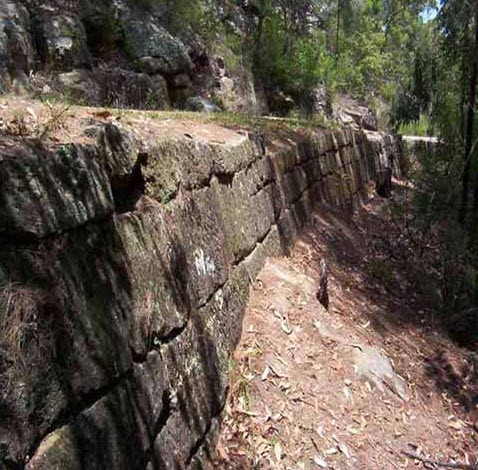All ferries are operated by Birdon Ferries. To check if they are running, either check the live camera below, or call 1300 247 366

It contains the most spectacular evidence of the road and in early 2008 was nominated for World Heritage Listing. Here the National Parks & Wildlife Service, which manages the road as far as Ten Mile Hollow, has installed many interpretative signs.
Park your car on the shoulder opposite the entrance way to The Great North Road.
You are now entering The Dharug National Park and you will now commence climbing the steep Devines Hill, where substantial work was involved in cutting away the hillside and building up retaining walls. Limited by the size of their hand tools, the convicts removed sandstone to achieve the required road level. In some parts they had to cut away five layers of stone from the rock-face while building massive retaining walls to support the outer edge of the road. Graffiti from 1830 can be seen high on one cut face.
Visit Hangmans Cave. It was so named in the late 1890s to impress and horrify tourists. (In fact, hanging could only be ordered by the Supreme Court and usually took place in the gaol yard.) The cave had a solid roof in the 1830s and was probably used as dry on-site storage.
Round the corner and above the cave is the site of the stockade for Iron Gang No.3. It had a well which offered a dependable supply of water. From 1830 onwards, soldiers were camped outside the stockade in order to guard this Iron Gang twenty-four hours a day. Farther up the hill, the Shepherds Gully track joins the western side of the road. This track was possibly built at the same time as the road. Giving access to the Macdonald River valley, it allowed the collection of timber from Wrights Creek and the procuring of fresh water from the river during drought.
On the east is Finchs Line. This was the original ascent, abandoned in 1828 as too steep and too long. (The Devines Hill route cut off two miles – about three kilometres.) This is the end of the section nominated for World Heritage and is the farthest most day trippers will walk. From here the road lies along the ridge-line and is now mostly travelled only by intrepid bushwalkers, cyclists or work vehicles. It is then joined from the south by the Western Commission Track.
This was built for the construction and service of the high-voltage electricity pylons and is now used for vehicular access to the Wat Buddha Dhamma retreat. From this junction to Ten Mile Hollow the Great North Road can at times be very busy. (Walkers should listen for motor vehicles.) Ten Mile Hollow, now a primitive camping area with a pit toilet but no water, was originally the site of a stockade, then of an inn. Here Simpsons Track heads east. One kilometre north of Ten Mile Hollow is Clares Bridge, built in 1830 at the head of a sweeping gully, where its design displayed the extensive skills of the road’s builders.
ALWAYS take a plentiful supply of water, food and sunscreen.